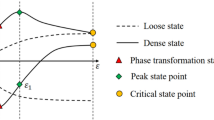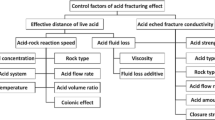Abstract
Gas condensate reservoirs are generally recovered using a pressure depletion drive. Gas can condensate into the liquid phase near the wellbore region when the reservoir pressure falls below the dew point pressure, which can kill gas deliverability. Wettability alteration is an effective means of overcoming this problem; core wettability can be altered from liquid-wet to gas-wet to alleviate the effect of condensate accumulation near the wellbore region. To establish the effect of fluoropolymer on wettability alteration in a gas-condensate reservoir, a gas-wetting alteration agent was synthesized by emulsion polymerization using different molar ratios of fluorine-containing monomers and acrylic monomers. FTIR and SEM were performed to analyze the structure of the gas-wetting agent. Contact angle measurements were used to assess surface alteration by the Owens two-liquid method. The effects of alteration agent concentration, salt concentration, pH and temperature on gas-wetting alteration were also evaluated. Results showed that the best molar ratio of fluoropolymer monomer to acrylic monomers was 1:2. The egg-like structure of the fluoropolymer latex on the core surface mainly contributes to gas-wetting alteration. The contact angles of brine and oil can be altered from 23° and 0° to 137° and 67° by 1 wt% FP-2 treatment, respectively. The surface free energy of the core was reduced from 67.52 to 1.66 mN/m. Moreover, the treated cores remain gas-wetting up to 100 g L−1 of salt solution, 120 °C and within the pH range of 5–7. This novel gas-wetting alteration agent can be used to solve the problem of liquid blocking effects in gas condensate reservoirs and improve gas recovery significantly.












Similar content being viewed by others
References
Danesh A, Henderson GD, Peden JM (1991) Experimental investigation of critical condensate saturation and its dependence on interstitial water saturation in water-wet rocks. SPE Reservoir Eng 6:336–342
Afidick D, Kaczorowski NJ, Bette S (1994). Production performance of a retrograde gas reservoir: a case study of the Arun Field. SPE 28749, SPE Asia Pacific Oil and Gas Conference, Melbourne, Australia, 7–10 November
Jin LC, Mahesh B (2016) Predicting microemulsion phase behavior for surfactant flooding. SPE 179701, SPE Improved Oil Recovery Conference, Tulsa, Oklahoma, 11–13 April
Delshad M, Najafabadi NF, Anderson GA (2006) Modeling wettability alteration in naturally fractured reservoirs. SPE 100081, SPE/DOE Symposium on Improved Oil Recovery, Tulsa, Oklahoma, 22–26 April
Najafabadi NF, Delshad M, Sepehrnoori K (2008) Chemical flooding of fractured carbonates using wettability modifiers. SPE 113369, SPE Symposium on Improved Oil Recovery, Tulsa, Oklahoma, 20-23 April
El-Banbi AH, McCain WD (2000) Investigation of well productivity in gas-condensate reservoirs. SPE 59773, SPE/CERI Gas Technology Symposium, Calgary Alberta, Canada, 3–5 April
Li K, Firoozabadi A (2000) Experimental Study of wettability alteration to preferential gas-wetting in porous media and its effects. SPE Reservoir Eval Eng 3:139–147
Barnum RS, Brinkman FP, Richardson TW (1995) Gas condensate reservoir behaviour: productivity and recovery reduction due to condensation. SPE 30767, SPE Annual Technical Conference and Exhibition, Dallas, Texas, 22–25 October
Tadros TF (1980) Thermodynamics of micellization of fluorocarbon surfactants. J Colloid Interf Sci 74:196–200
Li K, Firoozabadi A (2000) Phenomenological modeling of critical condensate saturation and relative permeabilities in gas/condensate systems. SPE J 5:1–10
Munkerud PK, Torsaeter O (1995) The effects of interfacial tension and spreading on relative permeability in gas condensate systems, European Symposium on Improved Oil Recovery, Vienna, Austria, 15–17 May
Fahes MM, Firoozabadi A (2007) Wettability alteration to intermediate gas-wetting in gas-condensate reservoirs at high temperatures. SPE J 12:397–407
Noh MH, Firoozabadi A (2008) Wettability alteration in gas-condensate reservoirs to mitigate well deliverability loss by water blocking. SPE Reservoir Eval Eng 11:676–685
Wu S, Firoozabadi A (2010) Permanent alteration of porous media wettability from liquid-wetting to intermediate gas-wetting. Transport Porous Med 85:189–213
Wang YL, Jin JF, Ma L (2015) Influence of wettability alteration to preferential gas-wetting on displacement efficiency at elevated temperatures. J Disper Sci Technol 36:1274–1281
Feng CY, Kong Y, Jiang GC (2012) Effect of organosilicon-acrylic emulsion treatment on wettability of porous media. Transport Porous Med 92:619–631
Tang GQ, Firoozabadi A (2000) Relative permeability modification in gas-liquid systems through wettability alteration to intermediate gas-wetting. SPE 81195, SPE Annual Technical Conference and Exhibition, Dallas, Texas, 1–4 October
Li Y, Jiang G, Xu W (2015) The effects of gas-wetting on the electrical properties of condensate gas reservoir cores. Energy Sources Part A 37:1766–1773
Wu S, Firoozabadi A (2009) Effect of salinity on wettability alteration of porous media from liquid wetting to intermediate gas wetting. J Petrol Technol 61:121–129
Kwok DY, Neumann AW (1999) Contact angle measurement and contact angle interpretation. Adv Colloid Interface 81:167–249
Jiang G, Li Y, Zhang M (2013) Evaluation of gas wettability and its effects on fluid distribution and fluid flow in porous media. Petrol Sci 10:515–527
Lewis GN, Randall M (1921) The activity coefficient of strong electrolytes. J Am Chem Soc 43:1112–1154
Kulkarni PV, Chapkhhane NK (2012) Development and testing of PTFE based composite bearing material for turbine pump. Int J Eng Adv Technol 1:15–20
Jin LC, Jamili A, Li Z (2015) Physics based HLD–NAC phase behavior model for surfactant/crude oil/brine systems. J Petrol Sci Eng 136:68–77
Jin LC, Jamilia A (2015) Modeling and interpretation of single well chemical tracer tests (SWCTT) for pre and post chemical EOR in two high salinity reservoirs. SPE 173618, SPE Production and Operations Symposium, Oklahoma City, Oklahoma, 1–5 March
Xie X, Liu Y, Sharma M (2009) Wettability alteration to increase deliverability of gas production wells. J Nat Gas Sci Eng 1:39–45
Huang PY, Chao YC, Liao YT (2004) Preparation of fluoroacrylate nanocopolymer by miniemulsion polymerization used in textile finishing. J Appl Polym Sci 94:1466–1472
Su C, Guo P, Li SL (2002) Investigation of the microvisual flow and relative permeability law of condensate oil and gas. Nat Gas Ind 22:61–64
Acknowledgments
The authors wish to thank the financial support and technical assistance from the Natural Foundation for Outstanding Youth of China (50925414), Fundamental Research Funds for the Central Universities (15CX06034A), China Scholarship Council (CSC) and the National Key Basic Research Program of China (2015CB250904), and I am also grateful to Dr. Bogdan Donose for fruitful discussions. All the funding agencies had no conflicts of interest in the study design, data collection, analysis, decision to publish, or preparation of the manuscript.
Author information
Authors and Affiliations
Corresponding authors
About this article
Cite this article
Jin, J., Wang, Y., Ren, J. et al. The Effect of Fluoropolymer on Wettability Alteration of Sandstone at Elevated Temperatures. J Surfact Deterg 19, 1241–1250 (2016). https://doi.org/10.1007/s11743-016-1866-z
Received:
Accepted:
Published:
Issue Date:
DOI: https://doi.org/10.1007/s11743-016-1866-z




